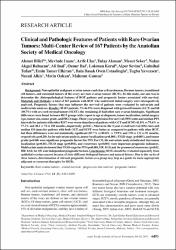| dc.contributor.author | Bilici, Ahmet | |
| dc.contributor.author | İnanç, Mevlüde | |
| dc.contributor.author | Ulaş, Arife | |
| dc.contributor.author | Akman, Tülay | |
| dc.contributor.author | Şeker, Mehmet | |
| dc.contributor.author | Babacan Akgül, Nalan | |
| dc.contributor.author | İnal, Ali | |
| dc.contributor.author | Bal, Öznur | |
| dc.contributor.author | Koral, Lokman | |
| dc.contributor.author | Sevinç, Alper | |
| dc.contributor.author | Tufan, Gülnihal | |
| dc.contributor.author | Elkıran, Emin Tamer | |
| dc.contributor.author | Ustaalioğlu Öven, Bala Başak | |
| dc.contributor.author | Yavuzşen, Tuğba | |
| dc.contributor.author | Alkış, Necati | |
| dc.contributor.author | Özkan, Metin | |
| dc.contributor.author | Gümüş, Mahmut | |
| dc.date.accessioned | 10.07.201910:49:13 | |
| dc.date.accessioned | 2019-07-10T19:36:24Z | |
| dc.date.available | 10.07.201910:49:14 | |
| dc.date.available | 2019-07-10T19:36:24Z | |
| dc.date.issued | 2013 | en_US |
| dc.identifier.citation | Bilici, A., İnanç, M., Ulaş, A., Akman, T., Şeker, M. ve Babacan Akgül, N. (2013). Clinical and pathologic features of patients with rare ovarian tumors: Multi-center review of 167 patients by the anatolian society of medical oncology. Asian Pacific Journal of Cancer Prevention, 14(11), 6493-6499. https://dx.doi.org/10.7314/APJCP.2013.14.11.6493 | en_US |
| dc.identifier.issn | 1513-7368 | |
| dc.identifier.uri | https://hdl.handle.net/20.500.12511/1152 | |
| dc.identifier.uri | https://dx.doi.org/10.7314/APJCP.2013.14.11.6493 | |
| dc.description.abstract | Background: Non-epithelial malignant ovarian tumors and clear cell carcinomas, Brenner tumors, transitional cell tumors, and carcinoid tumors of the ovary are rare ovarian tumors (ROTs). In this study, our aim was to determine the clinicopathological features of ROT patients and prognostic factors associated with survival. Materials and Methods: A total of 167 patients with ROT who underwent initial surgery were retrospectively analyzed. Prognostic factors that may influence the survival of patients were evaluated by univariate and multivariate analyses. Results: Of 167 patients, 75 (44.9%) were diagnosed with germ-cell tumors (GCT) and 68 (40.7%) with sex cord-stromal tumors (SCST); the remaining 24 had other rare ovarian histologies. Significant differences were found between ROT groups with respect to age at diagnosis, tumor localization, initial surgery type, tumor size, tumor grade, and FIGO stage. Three-year progression-free survival (PFS) rates and median PFS intervals for patients with other ROT were worse than those of patients with GCT and SCST (41.8% vs 79.6% vs 77.1% and 30.2 vs 72 vs 150 months, respectively; p=0.01). Moreover, the 3-year overall survival (OS) rates and median OS times for patients with both GCT and SCST were better as compared to patients with other ROT, but these differences were not statistically significant (87.7% vs 88.8% vs 73.9% and 170 vs 122 vs 91 months, respectively; p=0.20). In the univariate analysis, tumor localization (p<0.001), FIGO stage (p<0.001), and tumor grade (p=0.04) were significant prognostic factors for PFS. For OS, the univariate analysis indicated that tumor localization (p=0.01), FIGO stage (p=0.001), and recurrence (p<0.001) were important prognostic indicators. Multivariate analysis showed that FIGO stage for PFS (p=0.001, HR: 0.11) and the presence of recurrence (p=0.02, HR: 0.54) for OS were independent prognostic factors. Conclusions: ROTs should be evaluated separately from epithelial ovarian cancers because of their different biological features and natural history. Due to the rarity of these tumors, determination of relevant prognostic factors as a group may help as a guide for more appropriate adjuvant or recurrent therapies for ROTs. | en_US |
| dc.language.iso | eng | en_US |
| dc.publisher | Asian Pacific Organization for Cancer Prevention | en_US |
| dc.rights | info:eu-repo/semantics/openAccess | en_US |
| dc.subject | Overall Survival | en_US |
| dc.subject | Prognostic Factors | en_US |
| dc.subject | Progression-Free Survival | en_US |
| dc.subject | Rare Ovarian Tumors | en_US |
| dc.title | Clinical and pathologic features of patients with rare ovarian tumors: Multi-center review of 167 patients by the anatolian society of medical oncology | en_US |
| dc.type | article | en_US |
| dc.relation.ispartof | Asian Pacific Journal of Cancer Prevention | en_US |
| dc.department | İstanbul Medipol Üniversitesi, Tıp Fakültesi, Dahili Tıp Bilimleri Bölümü, Radyasyon Onkolojisi Ana Bilim Dalı | en_US |
| dc.identifier.volume | 14 | en_US |
| dc.identifier.issue | 11 | en_US |
| dc.identifier.startpage | 6493 | en_US |
| dc.identifier.endpage | 6499 | en_US |
| dc.relation.publicationcategory | Makale - Uluslararası Hakemli Dergi - Kurum Öğretim Elemanı | en_US |
| dc.identifier.doi | 10.7314/APJCP.2013.14.11.6493 | en_US |
| dc.identifier.wosquality | Q3 | en_US |
| dc.identifier.scopusquality | Q2 | en_US |


















